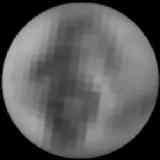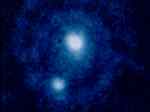Pluto




Pluto orbits beyond the orbit of Neptune (usually). It is much smaller than any of the official planets and now classified as a "dwarf planet". Pluto is smaller than seven of the solar system's moons (the Moon, Io, Europa, Ganymede, Callisto, Titan and Triton).
orbit: 5,913,520,000 km (39.5 AU) from the Sun (average)
diameter: 2274 km
mass: 1.27e22 kg
In Roman mythology, Pluto (Greek: Hades) is the god of the underworld. The planet received this name (after many other suggestions) perhaps because it's so far from the Sun that it is in perpetual darkness and perhaps because "PL" are the initials of Percival Lowell.
Pluto was discovered in 1930 by a fortunate accident. Calculations which later turned out to be in error had predicted a planet beyond Neptune, based on the motions of Uranus and Neptune. Not knowing of the error, Clyde W. Tombaugh at Lowell Observatory in Arizona did a very careful sky survey which turned up Pluto anyway.
After the discovery of Pluto, it was quickly determined that Pluto was too small to account for the discrepancies in the orbits of the other planets. The search for Planet X continued but nothing was found. Nor is it likely that it ever will be: the discrepancies vanish if the mass of Neptune determined from the Voyager 2 encounter with Neptune is used. There is no Planet X. But that doesn't mean there aren't other objects out there, only that there isn't a relatively large and close one like Planet X was assumed to be. In fact, we now know that there are a very large number of small objects in the Kuiper Belt beyond the orbit of Neptune, some roughly the same size as Pluto.
 Pluto has not yet been visited by a spacecraft.
Even the Hubble Space Telescope
can resolve only the largest features on its surface (left and above).
A spacecraft called New Horizons was launched in January 2006. If all goes well it should reach Pluto in 2015.
Pluto has not yet been visited by a spacecraft.
Even the Hubble Space Telescope
can resolve only the largest features on its surface (left and above).
A spacecraft called New Horizons was launched in January 2006. If all goes well it should reach Pluto in 2015.
Fortunately, Pluto has a satellite, Charon. By good fortune, Charon was discovered (in 1978) just before its orbital plane moved edge-on toward the inner solar system. It was therefore possible to observe many transits of Pluto over Charon and vice versa. By carefully calculating which portions of which body would be covered at what times, and watching brightness curves, astronomers were able to construct a rough map of light and dark areas on both bodies.
 In late 2005, a team using the Hubble Space Telescope discovered
two additional tiny moons
orbiting Pluto. Provisionally designated S/2005 P1 and S/2005 P2, they are now known as Nix and Hydra. They are estimated to be between 60 and 200 kilometers in diameter.
In late 2005, a team using the Hubble Space Telescope discovered
two additional tiny moons
orbiting Pluto. Provisionally designated S/2005 P1 and S/2005 P2, they are now known as Nix and Hydra. They are estimated to be between 60 and 200 kilometers in diameter.
Pluto's radius is not well known. JPL's value of 1137 is given with an error of +/-8, almost one percent.
Though the sum of the masses of Pluto and Charon is known pretty well (it can be determined from careful measurements of the period and radius of Charon's orbit and basic physics) the individual masses of Pluto and Charon are difficult to determine because that requires determining their mutual motions around the center of mass of the system which requires much finer measurements -- they're so small and far away that even HST has difficulty. The ratio of their masses is probably somewhere between 0.084 and 0.157; more observations are underway but we won't get really accurate data until a spacecraft is sent.
Pluto is the second most contrasty body in the Solar System (after Iapetus).
There has recently been considerable controversy about the classification of Pluto. It was classified as the ninth planet shortly after its discovery and remained so for 75 years. But on 2006 Aug 24 the IAU decided on a new definition of "planet" which does not include Pluto. Pluto is now classified as a "dwarf planet", a class distict from "planet". While this may be controversial at first (and certainly causes confusion for the name of this website) it is my hope that this ends the essentially empty debate about Pluto's status so that we can get on with the real science of figuring out its physical nature and history.
Pluto has been assigned number 134340 in the minor planet catalog.
Pluto's orbit is highly eccentric. At times it is closer to the Sun than Neptune (as it was from January 1979 thru February 11 1999). Pluto rotates in the opposite direction from most of the other planets.
Pluto is locked in a 3:2 resonance with Neptune; i.e. Pluto's orbital period is exactly 1.5 times longer than Neptune's. Its orbital inclination is also much higher than the other planets'. Thus though it appears that Pluto's orbit crosses Neptune's, it really doesn't and they will never collide. (Here is a more detailed explanation.)
 Like Uranus, the plane of Pluto's equator is at almost
right angles to the plane of its orbit.
Like Uranus, the plane of Pluto's equator is at almost
right angles to the plane of its orbit.
The surface temperature on Pluto varies between about -235 and -210 C (38 to 63 K). The "warmer" regions roughly correspond to the regions that appear darker in optical wavelengths.
Pluto's composition is unknown, but its density (about 2 gm/cm3) indicates that it is probably a mixture of 70% rock and 30% water ice much like Triton. The bright areas of the surface seem to be covered with ices of nitrogen with smaller amounts of (solid) methane, ethane and carbon monoxide. The composition of the darker areas of Pluto's surface is unknown but may be due to primordial organic material or photochemical reactions driven by cosmic rays.
Little is known about Pluto's atmosphere, but it probably consists primarily of nitrogen with some carbon monoxide and methane. It is extremely tenuous, the surface pressure being only a few microbars. Pluto's atmosphere may exist as a gas only when Pluto is near its perihelion; for the majority of Pluto's long year, the atmospheric gases are frozen into ice. Near perihelion, it is likely that some of the atmosphere escapes to space perhaps even interacting with Charon. NASA mission planners want to arrive at Pluto while the atmosphere is still unfrozen.
The unusual nature of the orbits of Pluto and of Triton and the similarity of bulk properties between Pluto and Triton suggest some historical connection between them. It was once thought that Pluto may have once been a satellite of Neptune's, but this now seems unlikely. A more popular idea is that Triton, like Pluto, once moved in an independent orbit around the Sun and was later captured by Neptune. Perhaps Triton, Pluto and Charon are the only remaining members of a large class of similar objects the rest of which were ejected into the Oort cloud. Like the Earth's Moon, Charon may be the result of a collision between Pluto and another body.
Pluto can be seen with an amateur telescope but it is not easy. There are several Web sites that show the current position of Pluto (and the other planets) in the sky, but much more detailed charts and careful observations over several days will be required to reliably find it. Suitable charts can be created with many planetarium programs.
Charon ( "KAIR en"  ) is Pluto's largest satellite:
) is Pluto's largest satellite:
orbit: 19,640 km from Pluto
diameter: 1212 km
mass: 1.90e21 kg
Charon is named for the mythological figure who ferried the dead across the River Acheron into Hades (the underworld).
(Though officially named for the mythological figure, Charon's discoverer was also naming it in honor of his wife, Charlene. Thus, those in the know pronounce it with the first syllable sounding like 'shard' ("SHAHR en").
Charon was discovered in 1978 by Jim Christy. Prior to that it was thought that Pluto was much larger since the images of Charon and Pluto were blurred together.
Charon is unusual in that it is the largest moon with respect to its primary planet in the Solar System (a distinction once held by Earth's Moon). Some prefer to think of Pluto/Charon as a double planet rather than a planet and a moon.
Charon's radius is not well known. JPL's value of 586 has an error margin of +/-13, more than two percent. Its mass and density are also poorly known.
Pluto and Charon are also unique in that not only does Charon rotate
 synchronously but Pluto does, too:
they both keep the same face toward one another.
(This makes the
phases
of Charon as seen from Pluto very interesting.)
synchronously but Pluto does, too:
they both keep the same face toward one another.
(This makes the
phases
of Charon as seen from Pluto very interesting.)
Charon's composition is unknown, but its low density (about 2 gm/cm3) indicates that it may be similar to Saturn's icy moons (i.e. Rhea). Its surface seems to be covered with water ice. Interestingly, this is quite different from Pluto.
Unlike Pluto, Charon does not have large albedo features, though it may have smaller ones that have not been resolved.
It has been proposed that Charon was formed by a giant impact similar to the one that formed Earth's Moon.
It is doubtful that Charon has a significant atmosphere.


|
|---|
|
|